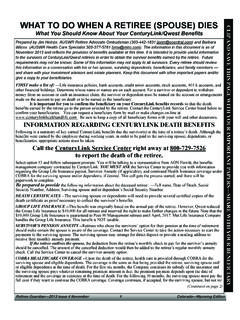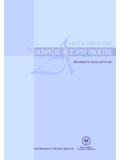Transcription of Fire Fighter FACE Report No. 2011-14, Career Fire Fighter ...
1 Page i January 18, 2012 2011 14 Career fire Fighter Dies in church fire following roof collapse indiana Executive Summary On June 15, 2011, a 40-year-old male Career fire Fighter (the victim) lost his life at a church fire after the roof collapsed, trapping him in the fire . At 1553 hours, the victim s department was dispatched to a Report of a church fire at an unconfirmed address. Units arriving on scene observed visible flames and heavy smoke coming from the roof of the church . A second alarm was immediately requested due to the lack of hydrants in this area. Initially, the incident commander (IC) sent in a truck crew consisting of an officer and 4 fire fighters, followed by 2 fire fighters (including the victim) from the arriving engine company for search and suppression activities.
2 The interior crew was initially met with visible conditions, light smoke, and no visible fire within the church . Conditions quickly changed after walls and areas of the ceiling were opened, exposing a fire engulfed attic space. A decision was then made to evacuate the building due to the amount of fire burning above the fire fighters. At this same moment (approximately 1610 hours), the roof began to collapse into the church where the fire fighters were working, trapping the victim and injuring others as they exited out of windows or ran from the collapse . Due to the magnitude of the fire , the fire department was unable to return to the collapsed area to rescue the victim. The victim s body was later recovered after the fire was extinguished.
3 Contributing Factors Initial size-up did not fully consider the impact of limited water supply, available staffing, the occupancy type, and lightweight roof truss system Risk management principles not effectively used High risk, low frequency incident Rapid fire progression Incident scene. (Photo courtesy of Star Press.) Page ii Report # F2011-14 Career fire Fighter Dies in church fire following roof collapse indiana Offensive versus defensive strategy Failure to fully develop and implement an occupational safety and health program per NFPA 1500 fire burned undetected within the roof void space for unknown period of time roof collapse . Key Recommendations fire departments should ensure that a complete situational size-up is conducted on all structure fires fire departments should use risk management principles at all structure fires fire departments should conduct pre-incident planning inspections of buildings within their jurisdictions to facilitate development of safe fireground strategies and tactics.
4 The National Institute for Occupational Safety and Health (NIOSH), an institute within the Centers for Disease Control and Prevention (CDC), is the federal agency responsible for conducting research and making recommendations for the prevention of work-related injury and illness. In 1998, Congress appropriated funds to NIOSH to conduct a fire Fighter initiative that resulted in the NIOSH fire Fighter Fatality Investigation and Prevention Program which examines line-of-duty-deaths or on duty deaths of fire fighters to assist fire departments, fire fighters, the fire service and others to prevent similar fire Fighter deaths in the future.
5 The agency does not enforce compliance with State or Federal occupational safety and health standards and does not determine fault or assign blame. Participation of fire departments and individuals in NIOSH investigations is voluntary. Under its program, NIOSH investigators interview persons with knowledge of the incident who agree to be interviewed and review available records to develop a description of the conditions and circumstances leading to the death(s). Interviewees are not asked to sign sworn statements and interviews are not recorded. The agency's reports do not name the victim, the fire department or those interviewed. The NIOSH Report 's summary of the conditions and circumstances surrounding the fatality is intended to provide context to the agency's recommendations and is not intended to be definitive for purposes of determining any claim or benefit.
6 For further information, visit the program Web site at or call toll free 1-800-CDC-INFO (1-800-232-4636). D-side of church following collapse and control of the fire . (Photo courtesy of fire department.) Page 1 Report # F2011-14 Career fire Fighter Dies in church fire following roof collapse indiana Introduction On June 15, 2011, a 40-year-old male Career fire Fighter (the victim) lost his life at a church fire after the roof collapsed trapping him in the fire . On June 16, 2011, the fire Administration notified the National Institute for Occupational Safety and Health (NIOSH) of this incident. The NIOSH lead investigator contacted the fire department on June 16, 2011 regarding the incident.
7 On July 10 through July 15, 2011, two safety and occupational health specialists from the NIOSH fire Fighter Fatality Investigation and Prevention Program traveled to indiana to investigate this incident. The NIOSH investigators met with the fire department s deputy chief, training officer, chief arson investigator, and battalion chiefs; representatives from the local fire fighters union; a state fire marshal investigator; representatives with the indiana Department of Labor; and 9-1-1 center personnel. Interviews were conducted with fire fighters/officers directly involved with the incident, the local fire Fighter s union president, the incident commanders (IC), and operation s staff.
8 The NIOSH investigators visited, documented, and photographed the fire scene and structure. The NIOSH investigators reviewed photographs of the victim s personal protective equipment (PPE), self-contained breathing apparatus (SCBA), the fire s progression, and origin/cause investigation. The NIOSH investigators reviewed the victim s SCBA maintenance records, SCBA data logger information of two fire fighters with the victim at the time of the collapse , and death certificate. The NIOSH investigators also reviewed training records for the victim, both ICs, and fire fighters working with the victim at the time of the collapse ; dispatch radio transcripts; videos; and department standard operating procedures (SOPs).
9 fire Department At the time of this incident, this Career fire department was operating from 5 fire stations with 103 uniformed members serving a population of over 67,000 within an area of about 39 square miles. The population could increase to over 85,000 when the local university is in session. The fire department had five engines (two of these were spare engines), two quints, two rescue trucks (one was a spare), and two aerial platform trucks (one was a spare). The city currently utilizes a county EMS service to provide medical care and patient transport where needed. All field personnel worked a 24-hour duty shift (0700 to 0700) every other day for five days and then received 4 consecutive days off before repeating the schedule.
10 The fire department operated with approximately 30 personnel on each of three operating tours, which routinely included 2 captains and 5 lieutenants. Currently, the fire department attempts to maintain four personnel per apparatus as their minimum staffing per apparatus, but the current union contract with the city only specifies that there be a minimum staffing of three personnel per apparatus. However, there is no overall per shift minimum staffing level. The last time that fire personnel were hired was prior to 2009. The department currently has two certified incident safety officers (ISO), but no procedures are in place to have an ISO respond to fire incidents. The IC maintains this responsibility on the fireground unless he delegates this position to an individual on scene.















